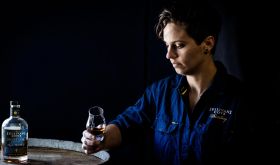Turning a dream into reality has been a labour of love, but we have finally made a gin we are proud of – and which potentially has liver-cleansing properties to boot!
What started out as a chance meeting with my future business partner through mutual friends over a couple of G&Ts (of course) has led me from promoting other people’s products – for Tanners Wine Merchants, Western Wines, Berkmann Wine Cellars and Champagne Pol Roger among others – to becoming a distiller.
In early 2013, Kathy Caton and I were introduced as 'people who really need to talk about gin together'. It turned out that she had a dream to launch Brighton's first-ever gin; and it didn’t take much persuading to get me signed up. Kathy's background is in radio production and presenting, having worked extensively for the BBC and currently hosting a weekly show on Brighton community station RadioReverb. Like me, she had no previous experience of making gin. Together, we embarked on two years of intensive research that resulted in us becoming the world's first female distilling duo.
A huge step towards us bringing the first legal gin distillery to Brighton came when I mentioned our plans to Johnny Ray, Drinks Editor of The Spectator, who is also based in Brighton. He was hugely excited by the idea and arranged for us to meet local entrepreneur Nigel Lambe. And, just as Johnny and Nigel were getting on board, Kathy introduced a friend of hers into the mix: ‘Easy’, a doctor of physics, taking the team to five members.
In July 2013, we purchased a vacuum still from eBay. The seller told us he was a movie-score composer and had been offered the still after filming had finished for The 51st State, in which it was used as a prop for drug-making equipment. Obviously this led to lots of Breaking Bad jokes, but that didn't distract us from the job at hand. Kathy and I spent every spare moment experimenting with the glass still, which involved Easy's soldering skills, some electronic wizardry to hook up and over-ride the heat settings on the hot plate, and the help of my largest saucepan to act as the water bath.

Experiments continuing, we moved on to a 30-litre copper still, confident (well, sort of) that our licence application to HMRC [the UK authority that governs alcohol production – RH] would soon be approved, and hopeful that the officer assigned to us would not be driven completely mad by our questions. Sure enough, we were granted our licence on 11 June 2014, an occasion Kathy and I aptly celebrated with a bottle of Veuve Clicquot La Grande Dame 1998.
With nothing to stop us, we now taught ourselves how to make gin from scratch. We found this to be the best way, and have confidence in our final process precisely because we reached it through trial and error, often using the oddest of equipment, always with little money and frequently late into the night.
There were so many botanicals I wanted to use and it was fascinating tweaking different ingredients to get the balance right. I'm pleased that we eventually simplified our recipe to give a very smooth, juniper-led and citrusy gin.
Our first distillation was made with juniper, dried orange peel, black pepper, hibiscus flower and orris root. It was an amazing feeling when the distillate came off the still and actually tasted like gin, albeit a warm and overly intense one. The woody notes of dried orange weren't quite what I wanted, so we experimented with fresh orange peel – and that, it transpired, was the flavour I was seeking.
I also really wanted to use milk thistle, because not only is it native to south-east England, but it's also known for its liver-cleansing properties (not least also for having a funny Latin name: Silybum marianum). Unfortunately, the first distillations I did with it came out tasting of silage.
We now cold-macerate our botanicals for 24 hours. This helps break down the essential oils in the juniper and citrus and makes a stunning bright green colour from the fresh lime. Where possible, using local produce is important, and the fact that we are using 100% organic British grain spirit (and the first coriander seed grown in Sussex) means we can offer a product that is ethically sourced.
The whole process of achieving the perfect recipe took us about five months, with many runs using lots of different spices and fruits. Every detail had to be written down so we could map exactly our process and replicate it in the future. Our biggest fear was that we would end up with a George’s Marvellous Medicine scenario of having the perfect gin but no hope of replicating it – thank you spreadsheets. And the final gin that we agreed upon as a team was blended just like vins clairs of non-vintage champagne, albeit in Brighton Station at nine o’clock in the morning!

The next task was to find a unique bottle. Unable to afford the bespoke route, we settled on an old whisky decanter made in the UK. And the label, which we wanted to encapsulate the colourful history of Brighton, was designed around an old pier ticket. The colour of the label, and the wax seal, came about when I rang the council’s maintenance department to ask what shade of paint they used for the seafront railings. They said it was called Brighton Seafront Blue and put me in touch with their supplier, who kindly mixed me up a pot for our printers to match.

Since that moment, there have been many moments of faintly ridiculous activity: when our first pallet of bottles arrived, for example, we had to handball all 1,056 of them in the rain and howling hail. We are now using a local wine merchants’ warehouse up the road and taking the bottles to our distillery in smaller batches! A good lesson learned.
We had our first batch of 400 bottles ready for sale on 11 December 2014. We then spent the day on the phone to prospective customers in Brighton and then out delivering. It's important to us that Brighton Gin is loved here before anywhere else. We made a gin for Brighton and we want local people to drink it and to share it with their friends.

Twelve months later, our lives are filled with making handcrafted spirit, waxing bottles with a makeshift iron-bottomed pan and a hotplate (although we have just purchased our first professional wax pot and now have 25 kgs of colour-matched wax – a proud moment!), manually labelling, boxing and delivering them – whether by bicycle or car, depending on the size of the order. Kathy and I worked out recently that the two of us – who are now working on Brighton Gin full time – are manually lifting over 3 tons of alcohol and glass a week.
I’m constantly looking into ways we can make our business more sustainable and energy efficient. Our third still was custom made for us, and uses a very small amount of energy and virtually no water. I send our spent botanicals to a local company who grow mushrooms on them to make gin-flavoured fungi! We are also recycling our cardboard boxes where possible – it's amazing how many people don’t want to throw them away.
The city (and beyond) seems to have embraced Brighton Gin with open arms; from independent wine shops to pubs, bars, restaurants and hotels. We are now stocked in Harvey Nichols and Fortnum and Mason, which makes our mums proud. Social media is playing a huge part in building awareness of the brand further afield. Indeed, we are looking forward to introducing our gin to other Brightons around the world – Brooklyn, Otago, Ontario and Melbourne!















